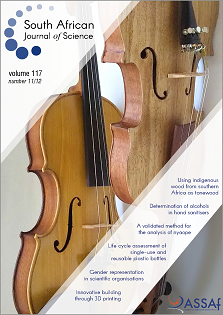Mechanical loading of primate fingers on vertical rock surfaces
DOI:
https://doi.org/10.17159/sajs.2021/10409Keywords:
human evolution, locomotion, climbing, suspension, bone curvatureAbstract
Mechanical loading of finger bones (phalanges) can induce angular curvature, which benefits arboreal primates by dissipating forces and economising the recruitment of muscles during climbing. The recent discovery of extremely curved phalanges in a hominin, Homo naledi, is puzzling, for it suggests life in an arboreal milieu, or, alternatively, habitual climbing on vertical rock surfaces. The importance of climbing rock walls is attested by several populations of baboons, one of which uses a 7-m vertical surface to enter and exit Dronkvlei Cave, De Hoop Nature Reserve, South Africa. This rock surface is an attractive model for estimating the probability of extreme mechanical loading on the phalanges of rock-climbing primates. Here we use three-dimensional photogrammetry to show that 82–91% of the climbable surface would generate high forces on the flexor tendon pulley system and severely load the phalanges of baboons and H. naledi. If such proportions are representative of vertical rock surfaces elsewhere, it may be sufficient to induce stress-mitigating curvature in the phalanges of primates.
Significance:
- We present the first three-dimensional photogrammetric analysis of a vertical rock surface climbed by a non-human primate, the chacma baboon (Papio ursinus).
- Our results show that a large proportion of a vertical rock wall would compel crimp and slope hand positions during climbing – grips that could explain the extraordinary phalangeal curvature expressed by a Middle Pleistocene hominin, Homo naledi.
Downloads
Published
Issue
Section
License

All articles are published under a Creative Commons Attribution 4.0 International Licence
Copyright is retained by the authors. Readers are welcome to reproduce, share and adapt the content without permission provided the source is attributed.
Disclaimer: The publisher and editors accept no responsibility for statements made by the authors
How to Cite
- Abstract 1440
- PDF 702
- EPUB 253
- XML 247
- Supplementary material 145












.png)